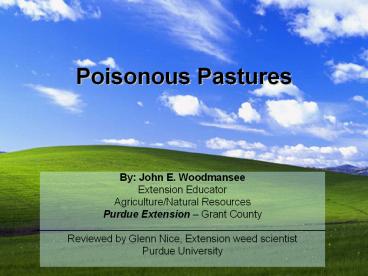Poisonous Pastures - PowerPoint PPT Presentation
1 / 34
Title:
Poisonous Pastures
Description:
Poisonous Pastures By: John E. Woodmansee Extension Educator Agriculture/Natural Resources Purdue Extension Grant County Reviewed by Glenn Nice, Extension weed ... – PowerPoint PPT presentation
Number of Views:153
Avg rating:3.0/5.0
Title: Poisonous Pastures
1
Poisonous Pastures
- By John E. Woodmansee
- Extension Educator
- Agriculture/Natural Resources
- Purdue Extension Grant County
- Reviewed by Glenn Nice, Extension weed scientist
- Purdue University
2
(No Transcript)
3
Introduction
- Your veterinarian will be the person to check
with for symptoms/treatments/cures - Some sources of information you find on this
subject may contradict each other - Well discuss most common plants as referenced in
Purdue Extension publication WS-9, Indiana
Plants Poisonous to Livestock and Pets
supported by many references/research
4
Source Purdue Extension publication WS-9,
Indiana Plants Poisonous to Livestock and Pets
- Available on-line at http//www.vet.purdue.edu/de
pts/addl/toxic/cover1.htm
5
Introduction
- In Indiana, poisonous plants far outnumber
poisonings - Animals generally prefer other plants to
poisonous plants may only eat poisonous plants
when nothing else is available - Poisonings most common in early spring, second
most common in winter
6
You suspect a poisoning
- Eliminate all other possibilities
- Positively identify suspected plant
- Match symptoms to those reported for plant
7
Prevention is the key!
- No antidotes for many of the poisons in plants
- Know the poisonous plants in your pasture and
control or keep animals away with fencing - Supply good forage or feed
- Avoid overgrazing
8
If an animal appears poisoned
- Avoid disturbing animal as much as possible
- Contact your veterinarian
- If practical or advised move animal(s) to fresh
pasture or give fresh feed/water
9
Animals react differently
- Individual animals within a species may react
differently - Different types of animals react differently
(e.g. cattle may be killed, but swine fine)
10
Possible Symptoms
- Birth defects
- Bleeding
- Blood clots in stools
- Blue coloration
- Breathing difficulties
- Death (sudden)
- Diarrhea
- Drooling
- Dullness, depression
- Excitedness, unusual behavior
- Gangrene
- Heart or pulse problems
- Jaundice
- Nausea
- Prostration
- Rash, sunburn
- Staggering, incoordination
- Stomach upset, colic
- Throat irritations
- Trembles, convulsions
11
WS-9 Plants that cause physical injury (skin,
eye, mouth, stomach, or hair-ball problems
mechanical injury to animals)
- Foxtail barley
- Common burdock
12
WS-9 House/Garden plants that poison
- Aroids (Jack-in-the-pulpit, philodenron, etc.)
- Bulb-bearing plants (lily-of-the-valley,
amaryllis, hyacinth, iris, daffodil, etc.) - English ivy
- Lupine, wild and cultivated (bluebonnet,
Quaker-bonnets) - Catnip
- Christmas plant (poinsettia)
- Rhubarb
- Azalea, rhododendron
- Castorbean
- Common tansey
13
WS-9 Forage and crop plants that poison
- Cultivated oats (nitrate poisoning)
- Ergot (a fungus parasite on heads of grasses)
- Tall fescue (varieties infected by Acremonium
endophytic fungus a mold) - Sweetclover, yellow and white
- Tobacco
- Alsike clover
14
WS-9 Woodland plants that poison
- Jack-in-the-pulpit (Indian turnip)
- Larkspur, dwarf and cultivated
- Dutchmans breeches, squirrelcorn (staggerweed,
bleeding heart) - White snakeroot (white sanicle, richweed)
- Brackenfern (brake fern)
- Groundsel (butterweed, ragwort)
- Green falsehellebore (white hellebore, Indian
poke)
15
WS-9 Marsh and streambank plants that poison
- Milkweeds
- Spotted waterhemlock (waterhemlock, spotted
cowbane) - Poison-hemlock
- Field horsetail, scouringrush
- Buttercups
- Nettle, stinging and wood
- Common cocklebur
16
WS-9 Plants of fields, roadsides, and open areas
that poison
- Redroot pigweed
- Mustard family (wild mustard, pennycress,
peppergrass, etc.) - Hemp (marijuana)
- Jimsonweed (thornapple)
- Spurges (prostrate spurge, cypress spurge, etc.)
- Common St. Johnswort (klamath weed)
- Star-of-Bethlehem (snowdrop, nap-at-noon)
- Common Pokeweed (pokeberry, pokeroot, inkberry,
poke) - Bouncingbet (soapwort)
- Nightshades (eastern black nightshade, Carolina
horsenettle, bull nettle, bitter nightshade,
climbing bittersweet) - Johnsongrass
17
WS-9 Trees and shrubs that poison
- Ohio buckeye
- Black walnut
- Wild black cherry
- Red oak
- Black locust
- Yew, English and Japanese
18
WS-9 Most common toxic plants in Indiana
- Alsike clover
- Bitter nightshade
- Black nightshade
- Common cocklebur
- Dutchmans breeches
- Dwarf larkspur
- Groundsel
- Johnsongrass
- Poison-hemlock
- Redroot pigweed
- Field horsenettle, Scouringrush
- Spotted waterhemlock
- Sweetclover
- White snakeroot
- Wild black cherry
- Yew
Source WS-9. All line drawings and pictures to
follow are from WS-9 unless noted.
19
Alsike Clover
Animals affected dogs, sheep, cattle, poultry,
caged birds
20
Bitter nightshade (also called bittersweet
nightshade, climbing nightshade)
Animals affected Calves, goats, sheep, swine,
poultry, rarely horses and cows
Line drawing USDA-NRCS PLANTS Database Bottom
photo credit George F. Russell _at_ USDA-NRCS
PLANTS Database
21
Black nightshade
Animals affected calves, goats, sheep, swine,
poultry, rarely horses and cows
Photo credit Purdue Extension CD-ROM, CD-AY-3,
Broadleaf Weed Seedling Identification.
22
Common cocklebur
Animals affected cattle, swine, sheep, poultry
23
Dutchmans Breeches
Animals affected cattle, horses
24
Dwarf larkspur
Animals affected cattle, horses, sheep
25
Groundsel (Senecio spp.)(also called
Cress-leaved groundsel, Butterweed, Ragwort)
Animals affected cattle, horses
26
Johnsongrass
Animals affected all types, especially ruminants
27
Poison-hemlock
Animals affected cattle, dogs, goats, swine,
horses, sheep, poultry
28
Redroot pigweed
Animals affected cattle, goats, sheep, swine
29
Field Horsetail, Scouringrush
Animals affected horses, rarely cattle and sheep
30
Spotted waterhemlock
Animals affected all livestock, especially cattle
31
Sweetclover
Animals affected cattle, horses, sheep, rabbits
32
White snakeroot
Animals affected cattle, horses, goats, sheep,
swine (if they eat roots)
33
Wild black cherry
Animals affected cattle, horses, dogs, goats,
swine, cats, caged birds
34
Yew(also called English or Japanese Yew, Taxus
spp.)
Animals affected all livestock (especially
horses), dogs, caged birds

